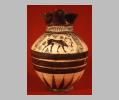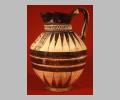
Overview: main panel

Main panel: elevated view

Overview: right profile
| Collection: | Museum of Art and Archaeology, Univ. of Missouri-Columbia |
| Summary: | Grazing goat. |
| Ware: | East Greek |
| Date: | ca. 600 BC |
| Dimensions: | H. 30.0 cm; H. without handle 28.0 cm; W. 20.9 cm. |
| Primary Citation: | |
| Shape: | Oinochoe |
| Ceramic Phase: | Chian Late Wild Goat Style |
| Period: | Archaic |
Condition:
Glaze flaking on back of neck, at base of handle, on shoulder to left of handle. Glaze fired red on rays at base and below shoulder on left side, left of handle.
Decoration Description:
Panel: grazing goat and filling ornament, framed with vertical meanders (r.), below which are three thick bands accented with red stripes, above a band of abbreviated guilloche, s-curves with dots. Band of rays at bottom and the sides of the shoulder are decorated with impressive pendant rays, alternately red and black. Outline drawing for the goat's head, hooves, and belly-stripe, the latter with a row of dots. Added red on body and horns. The filling ornament consists of palmette in lower right corner, pendant oval, hatched triangles, swastika, concentric circles with dots, checkered triangle. Below the handle there is a rectangular panel with horizontal wavy lines; the area above this is plain. Two vertical lines are on each side of handle, the outer thin, the inner broad, with added red. At the junction of the neck and shoulder, and on neck and mouth, black bands with added red stripes. On the exterior of the mouth there are reserved triangles at the base of the indentations of the trefoils, with smaller black triangles inside these. For the handle, the center roll is black, the outer rolls are decorated with short horizontal strokes; the rotelles are hatched on the outer face, black on the handle side.
R. M. Cook (1973) dated this oinochoe, and suggested an origin in or near Chios. Indeed, several elements of decoration, when taken together, support this: the white slip, the pinkish-buff clay, the sparse and neatly drawn filling ornament — particularly the pendent oval and the hatched triangle — the goat's reserved belly-stripe with interior row of dots, the broken cable pattern on the neck — especially as it hooks from right to left — the extensive use of rays, and the size and configuration of the oinochoe. Chian pottery of this period is of consistent, high quality; it has finesse and control (compare
The knobbed-horned variety of goat, capra aegagrus, has wide distribution over Asia Minor, on Crete, Rhodes, and many of the other Cycladic islands. Similar goats are depicted on ancient Luristan and Scythian metalwork, see From the Lands of the Scythians (Metropolitan Museum of Art, New York 1975) no. 171. Such motives on Greek vases may have been inspired by designs from Near Eastern minor arts and tapestries: see a row of reindeer on a rug from a Scythian tomb, M. Dimand and J. Mailey, Oriental Rugs in the Metropolitan Museum of Art (New York 1973) fig. 8.
Pottery of similar East Greek style first came to light in modern times at Naukratis in Egypt and it was dubbed "Naucratite," suggesting the place of origin. But when more pieces of this fabric were discovered in yet earlier archaeological contexts on Chios, the latter was seen as the pottery center. There is controversy as to whether Chios was the exclusive place of manufacture or whether, as Boardman feels, it was also made in Naukratis ("Chian and Naucratite," BSA 51 [1956] 55-56). For Chiot pottery known before 1949, cf. R. M. Cook, "The Distribution of Chiot Pottery," BSA 44 (1949) 154-161; also J. Boardman, Excavations in Chios 1952-1955: Greek Emporio (Oxford 1967) 148-152 and Excavations at Tocra 1963-1965 (Oxford 1966) 57-63. It is uncommon to find a single motif in a panel: recently on the California market (Ancient Vases [Catalogue 4, November 1978] The Summa Galleries, Inc., no. 4), there appeared an oinochoe with bird motif in a panel, now the Elvehjem Museum of Art (1979.79). The source of manufacture of designs such as this is thought by some to be either Samos or Rhodes. For the most recent discussion with bibliography: Kunst der Antike: Schätze aus norddeutschen Privatbesitz (1977) 214, no.
Shape Description:
Broad ring foot; globular body with steeply flaring shoulder; short, thick neck; vertical triple-rolled handle rising above trefoil mouth; rotelles on each side of the handle.
Material Description:
Reddish buff micaceous clay with cream slip.
Essay:
Collection History:
Museum purchase.
Sources Used: